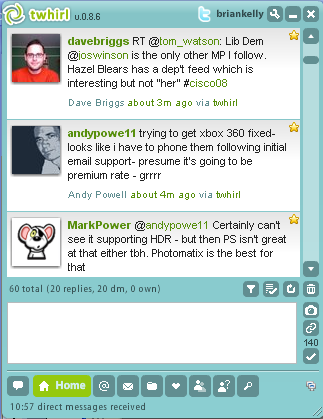An Introduction To Twitter
What Is Micro-blogging?
Micro-blogging is defined in Wikipedia as “a form of blogging that allows users to write brief text updates (usually 140 characters) and publish them, either to be viewed by anyone or by a restricted group which can be chosen by the user. These messages can be submitted by a variety of means, including text messaging, instant messaging, email, MP3 or the Web” [1] [2]. Popular examples of micro-blogging services include Twitter and FriendFeed.
What Is Twitter?
Twitter, the most popular example of a micro-blogging service was launched in July 2006. Twitter allows users (who can register for free) to send brief posts (sometimes known as ‘tweets‘) which can be up to 140 characters long. The tweets are displayed on the users profile page and are delivered to users who have chosen to receive them by following the users’ tweets. Readers of a user’s tweets are referred to as ‘followers‘.
Although the tweets will be delivered to a user’s followers, the tweets can normally be accessed by anyone, even users who have not signed up to Twitter. They are published on the user’s Twitter home page and can also be accessed by an RSS feed.
Twitter Clients
 For many the initial experience with a micro-blogging service is Twitter. Initially many users will make use of the Twitter interface provided on the Twitter Web site. However regular Twitter users will often prefer to make use of a dedicated Twitter client, either on a desktop PC or one a mobile device such as an iPhone or iPod Touch.
For many the initial experience with a micro-blogging service is Twitter. Initially many users will make use of the Twitter interface provided on the Twitter Web site. However regular Twitter users will often prefer to make use of a dedicated Twitter client, either on a desktop PC or one a mobile device such as an iPhone or iPod Touch.
As well as allowing tweets to be read and posted Twitter clients often allow Twitter followers to be put into groups, Twitter posts content searched, etc.
The Echfon iPod application [3] and the Twhirl [4] and TweetDeck applications for the PC [5] are both popular. An example of how TweetDeck is being used is described at [6].
Use Of Twitter
Examples of uses of Twitter in the cultural heritage sector include:
- Brooklyn Museum
- A pioneer in the museum sector. See <http://twitter.com/brooklynmuseum>
- Scottish Library and Information Council (SLIC) and CILIP in Scotland
- See <http://twitter.com/scotlibraries>
- Organisers of the Museums and the Web 2009 Conference
- Use of Twitter to support its annual conference. See <http://twitter.com/mw2009>
- The Getty Museum
- See <http://twitter.com/GettyMuseum>
As can be seen from these examples and articles at [7], [8] Twitter can be used by professional bodies and institutions as well as by individuals.
Getting Started With Twitter
If you wish to evaluate Twitter either to support individual interests or those of your organisation you would be advised to register and allow yourself a period of several weeks in order to give you time to ‘get Twitter’ [6]. Remember that you will probably need to follow a critical mass of Twitter users to gain tangible benefits and you will also need to post as well as read tweets to gain the benefits of membership of a viable Twitter community. You should also remember that Twitter may not be for you – you do not need to use Twitter; rather you should be able to use it if it is beneficial.
References
- Micro-blogging, Wikipedia,
<http://en.wikipedia.org/wiki/Micro-blogging> - An Introduction to Micro-blogging, UKOLN Cultural Heritage Briefing Document No. 35,
<http://www.ukoln.ac.uk/cultural-heritage/documents/briefing-35/> - EchoFon, <http://www.twitterfon.com/>
- Twhirl,
<http://www.twhirl.org/> - TweetDeck,
<http://www.tweetdeck.com/beta/> - Getting Twitter, UK Web Focus blog, 21 Oct 2008,
<http://ukwebfocus.wordpress.com/2008/10/21/getting-twitter/> - Learning from our Twitter xperiment,Lynda Kelly, 20 Aug 2008,
<http://museum30.ning.com/profiles/blogs/2017588:BlogPost:9689> - Twitter for Librarians: The Ultimate Guide, 27 May 2008,
<http://www.collegeathome.com/blog/2008/05/27/twitter-for-librarians-the-ultimate-guide/>
Filed under: Microblogs, Needs-checking
